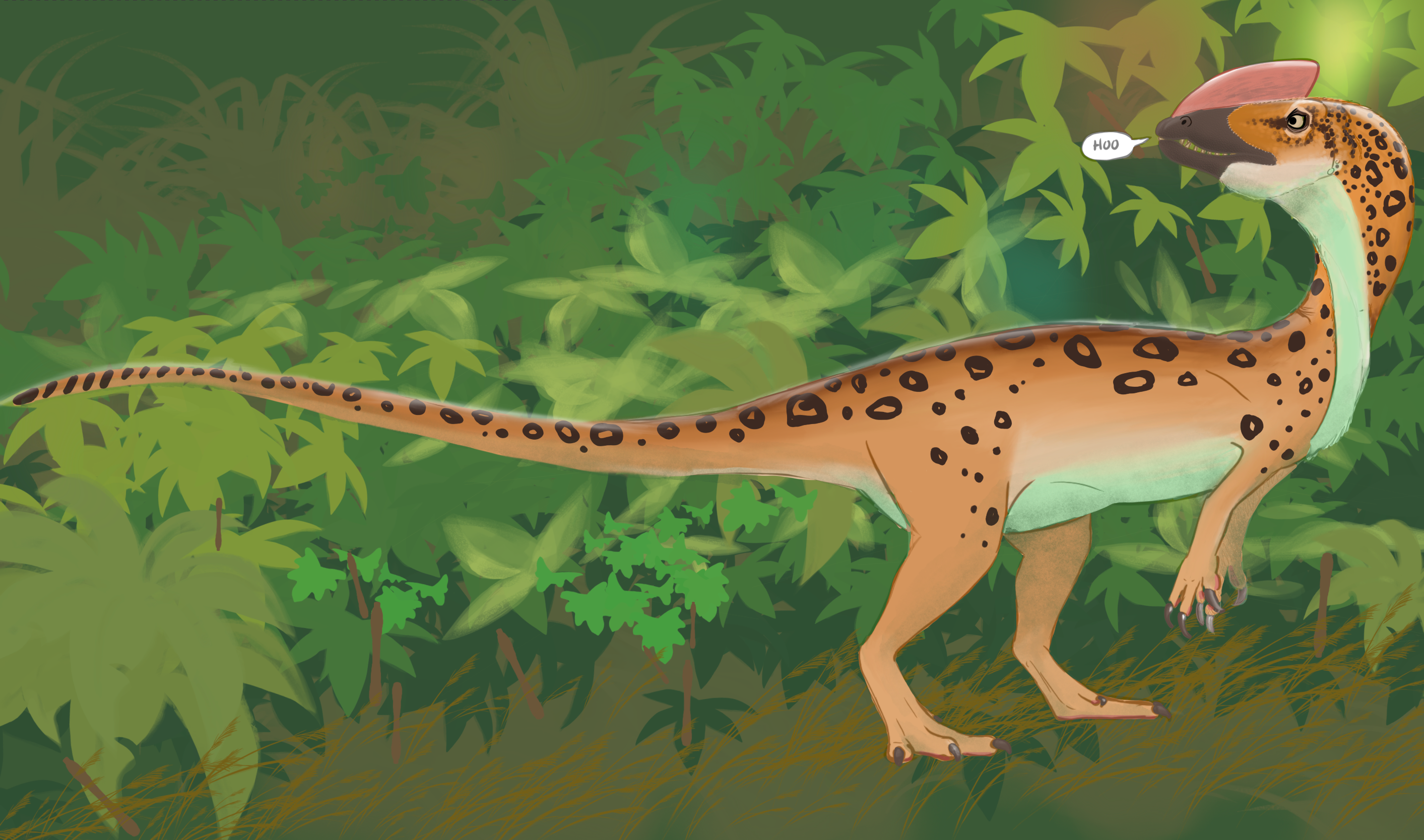I recently read Jurassic Park for the first time. Can you believe it? I’ve seen all the original movies, but hadn’t picked up the books until now. (I haven’t seen Jurassic World other than the first movie…I’m just not a big movie person and as I’ve heard it put aptly, JP was made for people who liked dinosaurs while JW is for people who liked JP.) I was pleasantly surprised that the book mostly avoided the tropey pitfalls the movie is famous for, and provided more scientific justification for animal behaviors and how the genetic engineering and computer system worked. In this post, I’ll share my thoughts on both Jurassic Park (1990) and the sequel The Lost World (1995).
Things it got right
When Jurassic Park was written, it wasn’t yet widely accepted that dinosaurs were warm-blooded, erect-standing, and active animals. If you’ve ever seen Fantasia’s “Rite of Spring”, you’ll know that dinosaurs used to be popularly shown as slow, tail-dragging, stupid reptiles that went extinct due to their own incompetence. By 1990, many lines of evidence were pointing toward the warm-blooded hypothesis (see my book review of The Dinosaur Heresies for more details), but not only were there scientists who still favored the old hypothesis, this new view had not made it into the public awareness yet. Jurassic Park was the first mainstream depiction of dinosaurs as birdlike, erect, active animals, and it changed how non-paleontologists thought of dinosaurs completely. This is true of both the book and the movie. However, there are certain details where the movie is wrong but the book is right.
Cearadactylus is quadrupedal and fluffy.
While pterosaurs don’t show up in the first movie at all, when they appear in The Lost World and Jurassic Park III, they’re scaly and they walk on their hind legs. However, they briefly appear in the first book and walk on all fours, which was very speculative at the time. Grant, the in-universe paleontologist, is excited that “Lederer’s speculation was right!” (281). However, no one on the Internet could find out who Lederer is; it seems like it’s not a real person.
While the quadrupedal pterosaur trackway Pteraichnus was described way back in 1957, it had been reattributed as crocodilian footprints sometime after its discovery and was ignored in studies of pterosaur terrestrial locomotion. [1] It wasn’t until after Jurassic Park was published that it was verified as being of pterosaur origin, so it’s impressive that Crichton was able to single out the correct locomotory mode from the numerous hypotheses vying for dominance at the time.
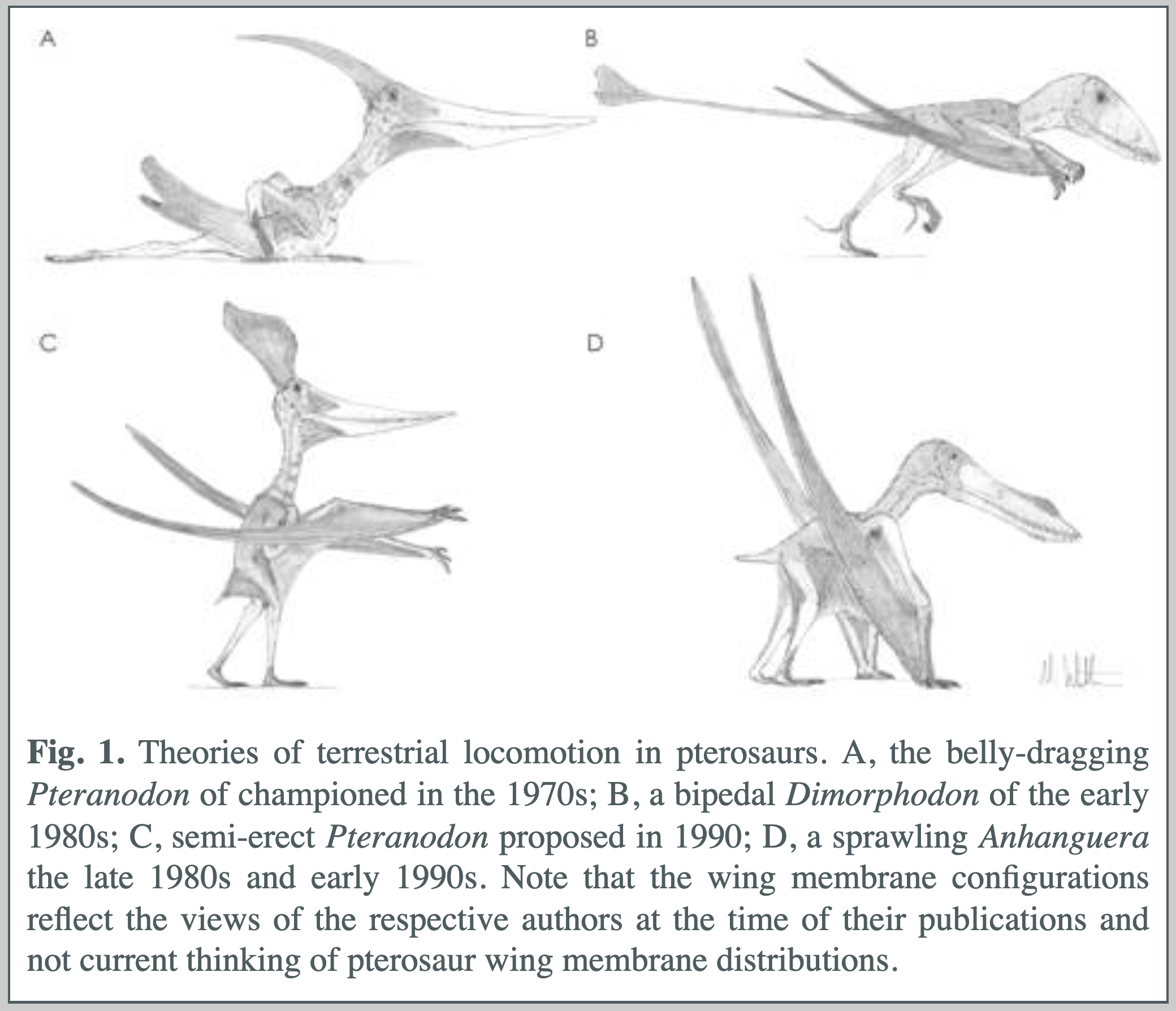
Grant isn’t surprised that they are fluffy, though, which makes sense; Sordes pilosus, a crow-sized pterosaur from Jurassic Kazakhstan, was described in 1971 and is covered in fuzzy pycnofibers.
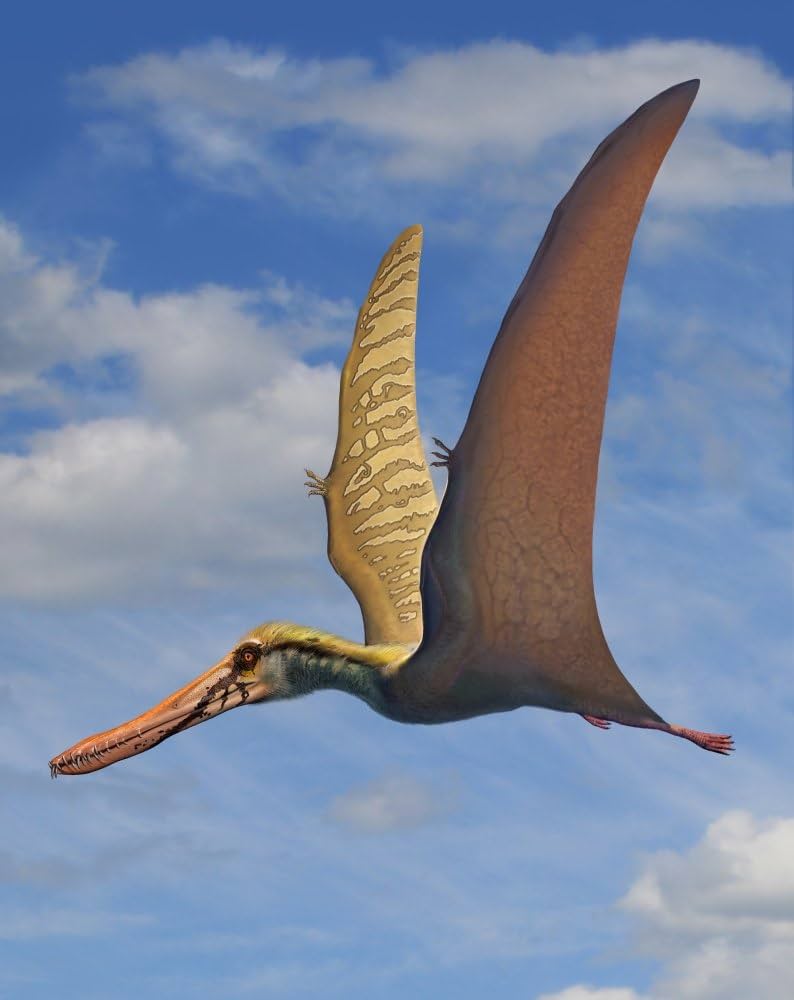
The way Grant identifies the pterosaur genus is strange, though. He thinks “these weren’t ordinary pterodactyls. They were too large. They must [sic] cearadactyls” (279). (My copy had the word “be” missing. Not sure if that’s true in other editions.) What exactly is an “ordinary pterodactyl”? That’s like saying this bear isn’t an ordinary bear, it’s a grizzly bear. It implies that there’s a standard genus, from which all others are variations. Anyway, Grant’s meaning, that the pterosaurs in the park, which have fifteen-foot wingspans and fish-eating teeth, must be Cearadactylus and not the gull-sized Pterodactylus, makes sense even if the way he says it doesn’t.
Dilophosaurus is big.
For some reason, the movie’s version of Dilophosaurus is miniaturized, standing about three feet high. The real Dilophosaurus was one of the first dinosaur apex predators and was the largest land animal known from Early Jurassic North America. It was six to eight feet (2 to 2.5 meters) tall from the ground to the top of its crests. The ones in the novel are ten feet tall, which is an exaggeration, or maybe just a trick of the characters’ perspective, but much closer to reality than the tiny movie version. While there’s no paleontological evidence of any dinosaurs being venomous, it’s a fun bit of speculation that’s not completely ruled out. Some birds, such as the pitohui, European quail, hoopoe, and others, consume poisonous foods and sequester the toxins in their bodies, making them toxic to eat. Dilophosaurus could have been doing something similar, or maybe even producing its own venom like the related Triassic archosauriform Uatchitodon is thought to have done.
The page image up top is my interpretation of the way Dilophosaurus is described in the novel. It doesn’t have a neck frill–that was just added in the movie for dramatic visual effect–and is leopard-patterned on the back and green underneath, with reddish crests. I think Dilophosaurus is a very attractive animal. It’s slender with long arms and a narrow chest, and the crocodile-like notch in the upper jaw and the dramatic crests are just so cool. In the book, its vocalizations are described as soft, owl-like hoots, which I think goes well with the rest of the image.
The scene in the movie in which a Dilophosaurus kills the double-agent software engineer Nedry is very toned down and a bit narmy, with a gore discretion shot showing only the outside of the car while Nedry is mauled to death by an animal half his size. In the book, the same scene is quite terrifying and beautifully written. I’ll just let you read it yourself (trigger warning: gore, horror).
The dinosaur stood forty feet away, at the edge of the illumination from the headlamps....The dinosaur stared at him and then snapped its head in a single swift motion. Nedry felt something smack wetly against his chest. He looked down and saw a dripping glob of foam on his rain-soaked shirt. He touched it curiously, not comprehending....
It was spit. The dinosaur had spit on him....The skin...was already starting to tingle and burn....It was almost like he had been touched with acid.
Nedry opened the car door, glancing back at the dinosaur to make sure it wasn't going to attack, and felt a sudden, excruciating pain in his eyes, stabbing like spikes into the back of his skull, and he squeezed his eyes shut and gasped with the intensity of it and threw up his hands to cover his eyes and felt the slippery foam trickling down both sides of his nose....Even as he realized it, the pain overwhelmed him, and he dropped to his knees, disoriented, wheezing....The earth shook beneath him and Nedry knew the dinosaur was moving, he could hear its soft hooting cry, and despite the pain he forced his eyes open and still he saw nothing but flashing spots against black. Slowly the realization came to him.
He was blind.
The hooting was louder as Nedry scrambled to his feet and staggered back against the side panel of the car, as a wave of nausea and dizziness swept over him. The dinosaur was close now, he could feel it coming close, he was dimly aware of its snorting breath. But he couldn't see. He couldn't see anything, and his terror was extreme. He stretched out his hands, waving them wildly in the air to ward off the attack he knew was coming. And then there was a new, searing pain, like a fiery knife in his belly, and Nedry stumbled, reaching blindly down to touch the ragged edge of his shirt, and then a thick, slippery mass that was surprisingly warm, and with horror he suddenly knew he was holding his own intestines in his hands....
Nedry fell to the ground...and then there was new pain on both sides of his head. The pain grew worse, and as he was lifted to his feet he knew the dinosaur had his head in its jaws, and the horror of that realization was followed by a final wish, that it would all be ended soon. (195)
There’s less unexplained monster-like behavior.
In the movies, the animals are shown doing numerous things that endanger themselves, such as thrusting their heads through glass, attacking much larger foes, and being generally hyper-aggressive. In the book, they do attack people (it’s necessary for there to be a plot), but the behavior is a lot less risky and more justified, and when they do show unusual aggression it’s lampshaded. Since they’re secretly breeding, the raptor population is way larger than can be supported by the rations the zookeepers provide, causing the animals to be desperate for more prey. The pterosaurs are fiercely territorial, and act to drive away the human intruders when they stumble into their aviary, but don’t pursue them when they leave. The Dilophosaurus, as I said, is much larger than the movie version, so a human is reasonably sized prey. As a counterexample, the Procompsognathus (“compys”), chicken-sized scavengers with a sedating bite, inexplicably attack human children. This behavior is never explained, but Grant lampshades it, saying, “The full animal would be about a foot tall. About as big as a chicken. Even a child would look pretty fearsome to it. It might bite an infant, but not a child” (46).
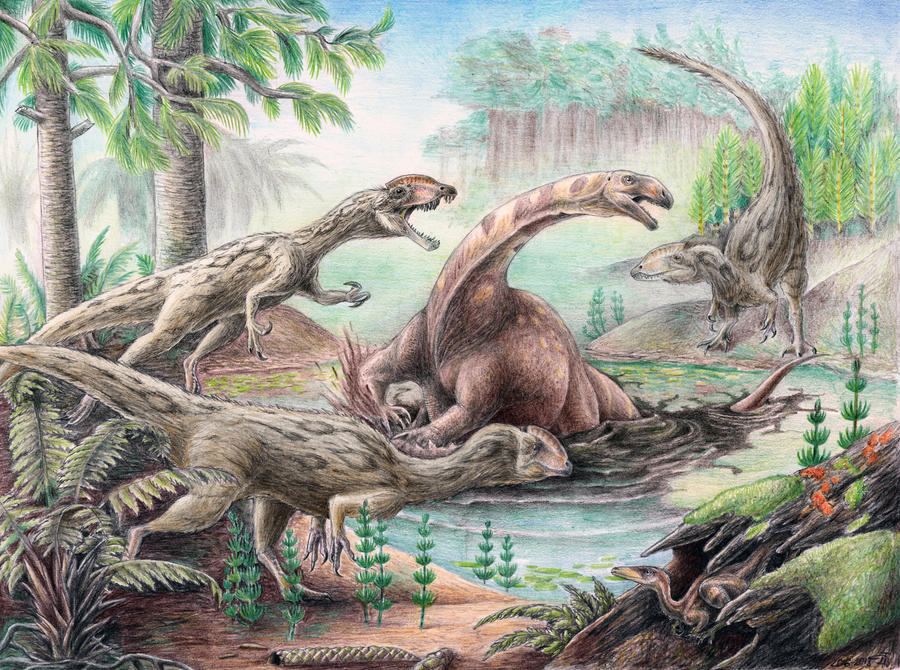
In what seems at first like a counterexample, the raptors exhibit many fearsome and maladaptive behaviors, such as cannibalism, infighting, and disorganized feeding frenzies. This seems like evidence against their supposed intelligence. However, it’s explained in the second book: more intelligent species have fewer hard-coded instinctual behaviors and a higher reliance on cultural learning. Human babies raised in the wild with no language, culture, or mentors would probably be similarly feral and not an accurate representation of what we consider normal. As the in-universe mathematician Ian Malcolm puts it, “Millions of years ago…their behavior would have been socially determined, passed on from older to younger animals. Genes controlled the capacity to make such patterns, but not the patterns themselves. Adaptive behavior was a kind of morality; it was behavior that had evolved over many generations because it was found to succeed–behavior that allowed members of the species to cooperate, to live together, to hunt, to raise young” (744). Since no one taught the raptors how to be raptors, they’re not very good at it.
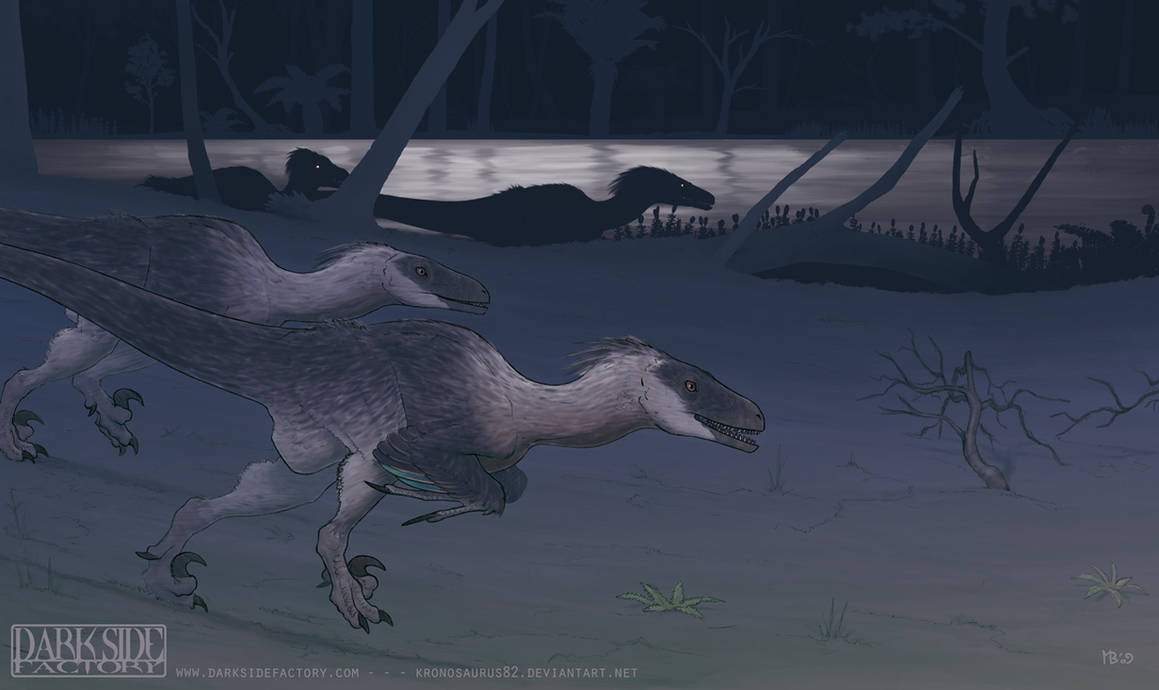
This is a good case study showing the risks associated with de-extinction. While we’ll never be able to clone dinosaurs in real life since the DNA is far too old, it’s likely that it will soon become technologically possible to bring woolly mammoths and other recently extinct species back to life. But elephants in particular are very intelligent and have complex culture, so an animal that’s a mammoth genetically still may not be one behaviorally. And is it cruel to bring a mammoth into a world devoid of mammoth culture?
The genetic engineering is more scientific.
In the movie, the park’s educational cartoon claims, “We use the complete DNA of a frog to fill in the holes”, something every biology nerd takes offense to. Frogs aren’t remotely closely related to dinosaurs! Why not use birds, or at least crocs or even lizards? Even a mammal would be a closer match than a frog.
The book doesn’t have this issue; it seems like the explanation just got cut down for the film to either reduce time or make it simpler for the audience. Here’s a conversation between head scientist Wu and paleontologist Grant:
"In order to make a complete strand, were you ever required to include DNA fragments from other species?"
"Occasionally, yes," Wu said. "It's the only way to accomplish the job. Sometimes we included avian DNA, from a variety of birds, and sometimes reptilian DNA."
"Any amphibian DNA? Specifically, frog DNA?"
"Possibly. I'd have to check." (169)
And some justification on why Wu included frog DNA:
When you compared the DNA of man and the DNA of a lowly bacterium, you found that only about 10 percent of the strands were different. This innate conservatism of DNA emboldened Wu to use whatever DNA he wished. In making his dinosaurs, Wu had manipulated the DNA as a sculptor might clay or marble. He had created freely (208).
The reason Grant asked specifically about the frog DNA is because of two observations: that the dinosaurs seem not to be able to see unmoving objects, and that they’re breeding even though all of them are supposedly female. Both of those are big topics, so we’ll unpack them separately.
With two different dinosaurs in two different situations, Grant notices that if he stands still, he’s invisible. One is with a Maiasaurus, and the other is in the first encounter with the Tyrannosaurus in the rain, when he is paralyzed with fear.
Again it approached Grant. This time the animal stopped, the black flaring nostrils just inches away. Grant felt the animal's startling hot breath on his face. But the tyrannosaur wasn't sniffing like a dog. It was just breathing, and if anything it seemed puzzled. No, the tyrannosaur couldn't see him. Not if he stood motionless. And in a detached academic corner of his mind he found an explanation for that, a reason why--
The jaws opened before him, the massive head raised up. Grant squeezed his fists together, and bit his lip, trying desperately to remain motionless, to make no sound. The tyrannosaur bellowed in the night air. But by now Grant was beginning to understand. The animal couldn't see him, but it suspected he was there, somewhere, and was trying with its bellowing to frighten Grant into some revealing movement. So long as he stood his ground, Grant realized, he was invisible. (190)
It’s well documented in frogs due to their popularity as pets and the negligence of many owners, that “a frog surrounded by dead flies on the ground, but no flying ones, will starve” [2]. It’s not that it can’t see motionless objects–after all, they don’t bump into things when moving around–but they don’t recognize it as food. Since these genetically engineered dinosaurs have frog DNA, they inherited this quirk of the visual system. If the genetic engineering program had continued, this would probably have been flagged as a bug, and corrected for future dinosaur versions. In general, nearly all inaccuracies in the dinosaurs of Jurassic Park can be explained Watsonianally, i.e. by blaming it on bugs in the DNA reconstruction.
In the second book, the dinosaurs don’t have this issue, maybe because they’re a different version, or maybe because Grant was misinterpreting the behavior in the first place (the rex just wasn’t hungry, or it was distracted by something else, or it was cautious of him). But in-universe, Grant published a paper after his experience in the park claiming that “a tyrannosaur could be confused by a driving rainstorm, because it was not adapted to wet climates” and another fictional paleontologist, Roxton, published a paper describing “casts of rex braincases, [concluding] that tyrannosaurs had the brain of a frog” (655). It’s unclear whether Roxton had some connection with the animals in the original Jurassic Park or if he came to the same conclusion coincidentally. These papers are mocked by the good guys in The Lost World, and believing them to be gospel gets some bad guys killed. I’m wondering if Michael Crichton changed his mind after the movie came out and viewers kept writing him to say there’s no way Tyrannosaurus couldn’t see motionless objects (since in the movie, it’s not clear that this behavior comes from the frog DNA and could be interpreted as a statement about the actual Tyrannosaurus).
Regarding the dinosaurs breeding even when all of them are supposedly female, Grant hypothesizes that some of them are changing sex due to the pressures of a single-sex society, a phenomenon also documented in frogs. Later, he captures a baby Velociraptor and intends to bring it back to the labs because he believes it to be a male, as evidence for this hypothesis.
Plot-wise, it’s obvious that Crichton needed the scientists to make a legitimate try at sterilizing the population, but the dinosaurs to overcome it, resulting in this situation. However, the mechanism doesn’t entirely make sense based on what we know now. Explaining that all the dinosaurs are female, head scientist Wu says, “The reason we know all the animals are female is that we literally make them that way: we control their chromosomes, and we control the intra-egg developmental environment. From a bioengineering standpoint, females are easier to breed. You probably know that all vertebrate embryos are inherently female. We all start life as females. It takes some kind of added effect…to transform the growing embryo into a male. But, left to its own devices, the embryo will naturally become female” (111). While this is true for mammals, who use the XY sex determination system, it’s actually not true for other vertebrates, especially birds, which use the similar but different ZW sex determination system. In birds, the males are homozygous, with two Z chromosomes, while the females are heterozygous, with one Z and one W. It’s not fully understood yet how the chromosomes affect embryo development, but there’s some evidence that male is the default sex for birds: female birds whose ovaries are damaged start expressing male plumage, indicating that female hormones suppress the underlying male tendency. Therefore, all the Jurassic Park dinosaurs should by default be male. In addition, this would be a more foolproof way to keep the dinosaurs from breeding, as males can’t lay eggs. However, the ZW sex determination system wasn’t discovered until the early 2000s.
Another way animals can reproduce without the opposite sex present is through parthenogenesis, which is partial or full cloning of a female. This was documented in lizards in the 1960s and ’80s, but they were small, specific studies and would not have been widely known; and furthermore, lizards can do a lot of things that birds can’t. However, in just the last couple of years, scientists have observed captive crocodiles and condors laying unfertilized eggs that developed into a fully formed clone of the mother. None of these parthenotes survived past early childhood; as the xkcd guy put it in What If?: Serious Scientific Answers to Absurd Hypothetical Questions, “A child from a parent who self-fertilized would be like a clone of the parent with severe genetic damage. The parent would have all the genes the child would, but the child wouldn’t have all the genes the parent did.” However, some animals, like the New Mexico whiptail lizard, reproduce exclusively through parthenogenesis, and therefore must be able to mitigate the genetic risk somehow. Anyway, this wasn’t known at the time of Jurassic Park’s writing, but it’s probably the explanation Crichton would have gone with if he wrote it today.
Tyrannosaurus babies are fluffy while the adults are scaly.
I was surprised to find that in the book, the baby tyrannosaurs in The Lost World are described as being downy, with a ring of white around the neck. The raptors are always described as having pebbly skin, as are adult tyrannosaurs, so I didn’t expect any feathered dinosaurs at all (since raptors are more closely related to birds than tyrannosaurs).

It was reasonable for the time that the original book would have described scaly raptors. After all, John Ostrom and Robert Bakker, the instigators of the Dinosaur Renaissance (and author of The Dinosaur Heresies), drew Deinonychus that way. Spielberg clearly used the drawing accompanying the 1969 description of the genus as reference for his raptor models.
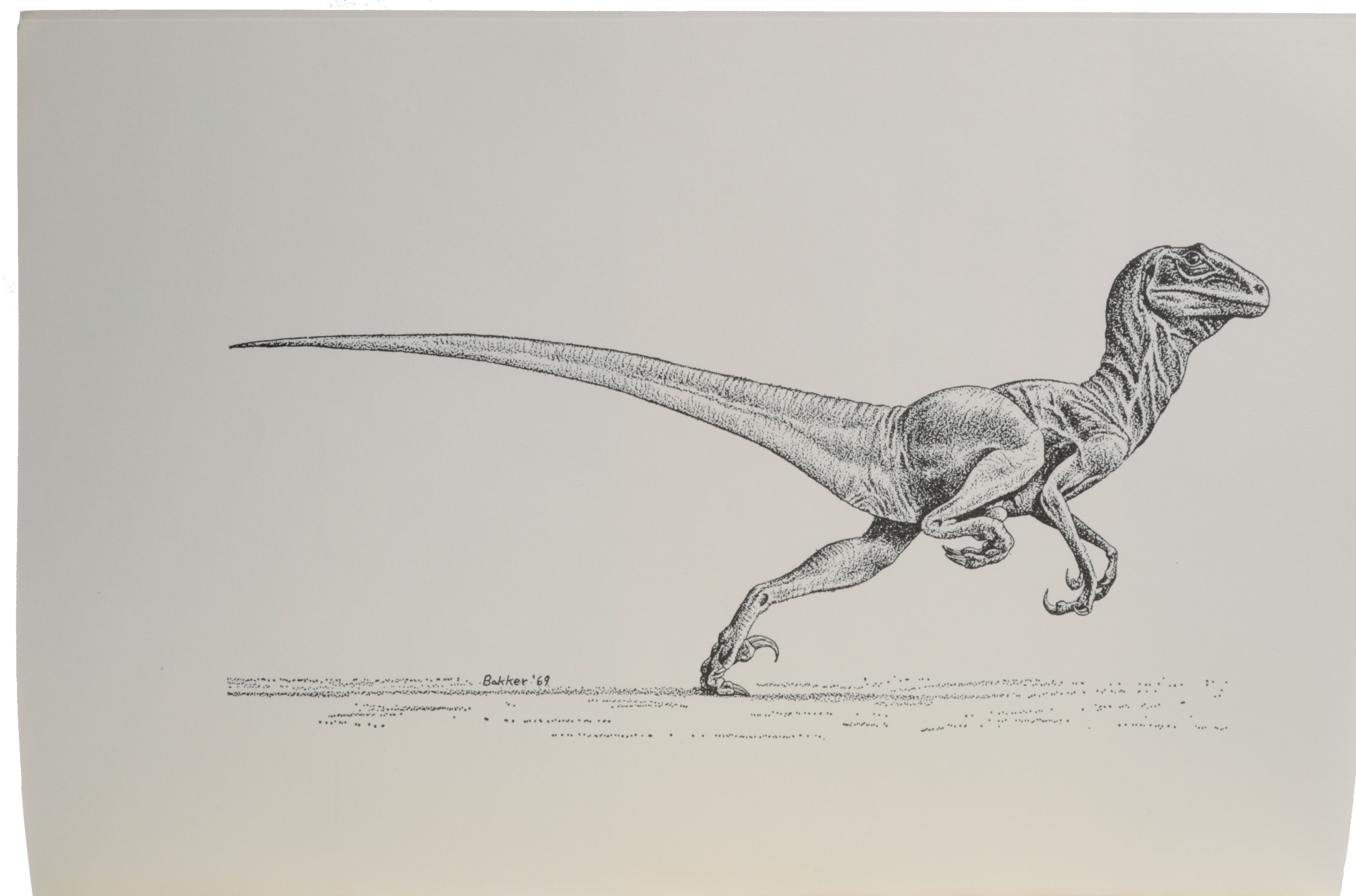
I’m wondering if Crichton changed his mind between the first and second book about the likelihood of dinosaurs having feathers, but with the success of the movie and its image of scaly raptors he couldn’t retcon the raptors into being feathery, and instead put feathers on a dinosaur that didn’t appear in the first book. Regardless, Spielberg decided not to include plumage on the model of the baby tyrannosaur in the second movie.
The inclusion of this detail is quite prescient, as The Lost World was published in 1995, and the first conclusive evidence of a non-avian dinosaur with fuzz was the small Chinese compsognathid Sinosauropteryx, published in 1996. The first evidence of a tyrannosaur with fuzz was Yutyrannus, published in 2012. Ornithischians like Tianyulong (2009), Kulindadromeus (2014), and Psittacosaurus (2016) were also found to have some sort of fuzzy or quilly integument. For awhile, these discoveries inspired people to feather all the dinosaurs, until later analyses of thermoregulation in large animals estimated that it was more likely for Tyrannosaurus (and anything over about a tonne) to be scaly. Crichton probably felt vindicated when he read these results. How did he guess correctly before the evidence was in? Possibly simply by following Ostrom and Bakker’s logic to its conclusion. The pair included an illustration comparing the skeletal anatomy of the forelimb of the reptilian-seeming Deinonychus with that of Archaeopteryx, which was indisputably a bird with full flight feathers.
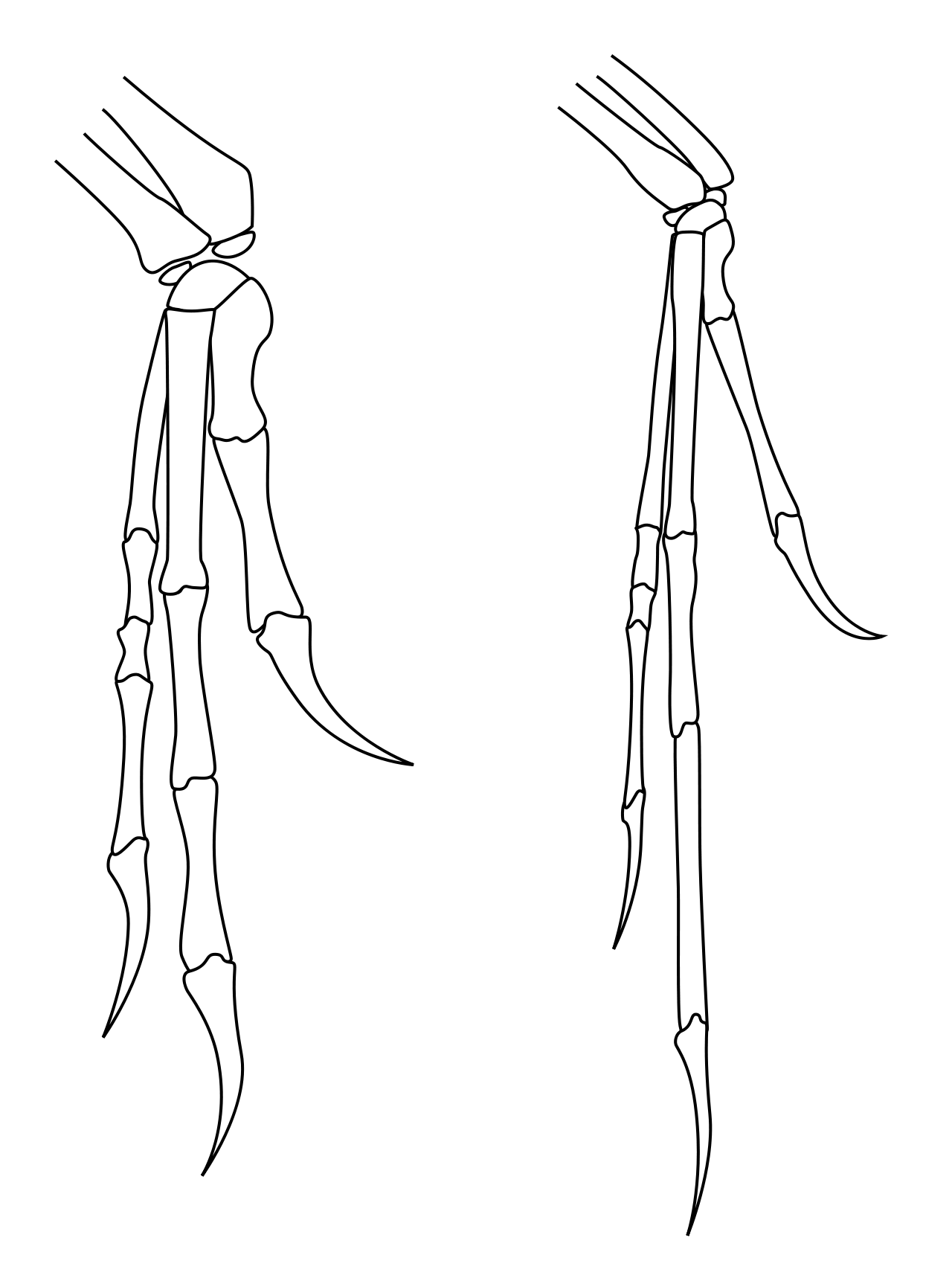
If Archaeopteryx, which lived much earlier than Deinonychus, had extensive feathering on those hands, wouldn’t you expect Deinonychus to as well?
The computers make more sense.
There’s a famous scene in the first movie in which the nerd kid is trying to use the computer to lock a door, and she sits down at the monitor and says, “It’s a UNIX system. I know this” and proceeds to click on various overly 3D-animated parts of the GUI, and then succeeds in locking the door. There’s a different famous scene in which the controls guy is trying to access the security system, and his attempts cause an animation of the software engineer Nedry to pop up and repeat, “Ah-ah-ah, you didn’t say the magic word!” Both of these are quintessential examples of Hollywood Hacking. Thankfully, the book isn’t like that at all. None of the hacking or counter-hacking done is very complicated, and therefore it’s actually pretty reasonable and well explained.
When the nerd kid is using the computer, he’s trying to restore the power to the building where Malcolm is laying injured and helpless, to turn on the electric fence to prevent raptors from entering. Everyone with experience using the control system has already been killed, and the kid does restore power by just clicking around, but he doesn’t glorify it with any technobabble and has to make a clever deduction in order to figure out what indicates the right building.
When Arnold, the controls guy, is trying to diagnose what Nedry did to shut down power and jam the phones, he has to debug the entire Jurassic Park program, which contains “more than half a million lines of code, most of it undocumented, without explanation” (219). Luckily for him, he had implemented a security / debugging feature to track all developers’ keystrokes, so he uses this to find out what lines Nedry had changed. Nedry first tries to turn off the keystroke logger, but Arnold had paranoidly (but correctly) removed users’ ability to do that without flipping a physical switch. Then he calls “whte_rbt.obj”, some block of code that he’d written earlier, which unlocks all doors and turns off the power. This is what starts the whole debacle, since the animals can now escape their electrified enclosures. Nedry had also written another block of code called “fini.obj”, which reverses the changes and then erases evidence of the “whte_rbt” call. He put this in so that he could come back and “fix” the system after dropping off the dinosaur embryos he’d stolen, to retain his job and not get caught. All Arnold has to do is locate the definitions of these blocks and then call “fini.obj”. The hack was simple and built to be reversible. No “ah-ah-ah”-ing required.
The women characters are badass.
In the first book, Ellie doesn’t actually get that much screen time, but the few scenes she does have are pretty cool. First, she’s obviously very knowledgeable about paleontology and paleobotany, and helps Grant identify the Procompsognathus fragment they were sent early on in the book. She also identifies poisonous ferns that are planted poolside, an early indication that the park isn’t as safe as it’s made out to be, and has a short monologue about how plants aren’t just a green background in front of which animals act, a sentiment that will resonate with any botanist.
Much later, someone needs to provide a distraction for the raptors so that Grant can get to the maintenance shed and restart the generator. Two of the men are injured and can’t run. Wu volunteers, but the group protests that he’s the only one who knows how to restart the computer system. Harding, the veterinarian, volunteers, but is rejected because he’s the only one who can care for the injured people. So Ellie volunteers without hesitation. One of the injured men objects, “but she was already bending over, lacing her running shoes. ‘Just don’t tell Grant,’ she said. ‘It’ll make him nervous’” (321). Then she survives a high-speed chase with the raptors by climbing to the roof, jumping off into the swimming pool, and then making it back inside, making her the only character who runs away from dinosaurs without injury in this book.
I also appreciate the fact that she’s nobody’s love interest. She’s engaged to an offscreen character, and is stated to be married to him by the events of the second book. When Gennaro, the lawyer, remarks that he wasn’t expecting a woman, she says simply, “These things happen” (62). Overall, a realistic and positive portrayal of a woman scientist. My one complaint is that in the narration, all the other characters except the children are called by their last names, while Ellie is called Ellie.
In the second book, Ellie doesn’t show up, and the role of action girl is filled by the mathematician Malcolm’s girlfriend, the field biologist Sarah Harding. She normally studies hyenas in Africa, but joins the group that includes two engineers, Malcolm, a rich guy named Levine, and two stowaway nerd kids (an improvement over the first book, which had one nerd kid and one useless jock kid). She’s repeatedly described as “muscle-bound”, which is important plot-wise because she achieves no less than three feats of superhuman strength in the course of the book. The way that she gets to the island is strange; the rest of them take a helicopter and expect her just to figure out her own passage, which she does, presumably because the other characters know she can handle herself. (She hitches a boat ride with the bad guys, who push her off the boat, but she swims the rest of the way through rough chop to the safety of a cave–her first feat of superhuman strength.) It’s a matter of taste whether or not you think it’s overdone, but either way she saves everyone’s ass many times through brawn, brains, and bravery.
The girl nerd kid, Kelly, idolizes her and isn’t disappointed. Sarah (she’s still the only first-name-basis adult, although it’s less consistent in this book and she’s sometimes called Harding) also makes sure to set straight the misconceptions about women’s aptitude for STEM that Kelly’s heard from her teachers, peers, and parents, and encourages her to take credit for her accomplishments (which includes saving everyone’s lives. There are ample opportunities to do so on a dinosaur-infested island). By the end of the book, I idolized her too.
Her relationship with Malcolm is also non-standard, with Malcolm being constantly injured and defeatist. When one of their connected trailers is hanging off the edge of a cliff, pushed there by territorial tyrannosaurs, Sarah sustains a head laceration from breaking glass, while Malcolm’s leg is more seriously injured. She quickly bandages her own head, then “mountain climb[s] through [the] damn kitchen” (704) to reach the breaker panel, and, hanging from one hand, successfully turns the electricity on to the trailer chassis, shocking the tyrannosaurs. Then she piggy-backs Malcolm down to the trailer’s exit, finds a coil of rope, climbs up the underside of the trailer, throws down the rope, and hauls Malcolm up. One of the engineers, Thorne, had climbed down the underside of the trailer to help attach Malcolm to the rope, and is slipping on his way back up, so she hauls him up by his hair as well.
Note that this is NOT how the scene played out in the movie at all. In the movie, Julianne Moore, the actress portraying Sarah, is very much not muscle-bound, and she screams, falls, and fails even to climb a rope, nearly killing the two men below her, while Malcolm (Jeff Goldblum) keeps a level head and tells her to “increase your rate of climb”. What a damn shame they didn’t do the scene as written! Such wasted potential badassery!
Sarah’s final Herculean feat occurs when she and the last remaining bad guy, Dodgson, are sheltering under a car from a tyrannosaur.
Quickly, she shifted her body, twisting around, moving so her head and shoulders were braced against the rear wheel of the car. Dodgson turned to look at her just as her boots began to push against his lower legs. Pushing them out from beneath the car. Terrified, Dodgson struggled, trying to push back, but her position was much stronger. Inch by inch, his boots moved out into the cold morning light. Then his calves. She grunted as she pushed, concentrating every ounce of her energy. In a high-pitched voice, Dodgson said, "What the hell are you doing?"
She heard the tyrannosaur growling. She saw the big feet move.
Dodgson said, "Stop it! Are you crazy? Stop it!" But Harding didn't stop. She got her boot on his shoulder, and pushed once more. For a while Dodgson struggled against her, and then suddenly his body moved easily, and she saw that the tyrannosaur had his legs in its jaws and was pulling Dodgson out from under the car. Dodgson wrapped his hands around her boot, trying to hold on, trying to drag her with him. She put her other boot on his face and kicked hard. He let go. He slid away from her.
She saw his terrified face, ashen, mouth open. No words came out. She saw his fingers, digging into the mud, leaving deep gouges as he was pulled away. And then his body was dragged out. Everything was strangely quiet. She saw Dodgson spin around onto his back, and look upward. She saw the shadow of the tyrannosaur fall across him. She saw the big head come down, the jaws wide. And she heard Dodgson begin to scream as the jaws closed around his body, and he was lifted up. (785)
In addition to her feats of strength, Sarah saves Thorne, the engineer, from chameleon-like Carnotaurus through quick thinking and unhesitating action. The animals are able to quickly change color to blend into the surroundings, and she figures out that they don’t like it when she turns the lights on and off, as it leaves them visible for a moment before they can change to match the new lighting. She’s able to drive them away by going outside and “swinging fistfuls of flashlights back and forth”, deputizing the rich guy Levine to do the same to increase their coverage. After they get back to safety, Levine says, “I was never so frightened in my entire life,” to which Sarah replies, “Get a grip on yourself” (767)
Lastly, in both books there are two child characters, a boy and a girl, though they’re different children in each book. In the first book, Tim (11) is a dinosaur geek who is also interested in computers, while Lex (7) is tough and interested in baseball. She’s always trying to get people to throw the ball with her and calling them wimps when they don’t throw it hard enough. When things get dangerous, though, she’s just a normal seven-year-old child, unable to control her emotions or help much. Tim has a few moments of triumph, like when he tricks a raptor into entering a walk-in freezer which he then locks behind it, and later restoring the power. In the movie, the roles are switched, and the girl child is the older and more competent one, perhaps as an intentional subversion of the trope that women aren’t interested in computers. I didn’t think Lex’s portrayal in the book was sexist though, as a competitive sports fanatic is an equally nontraditional role.
In the second book, the kids are both preteens, and both help out the adults numerous times. Arby, the boy, struggles with not being paralyzed when afraid, while Kelly struggles with self-confidence. While Arby’s contributions occur mainly in the beginning of the book–he deduces what Levine had been doing with a strange computer, allowing them to locate him, and he figures out how to connect to the old InGen network on the island–Kelly gets to save everyone no less than three times, after things get dangerous.
First, when Arby falls out of the high hide into a pack of raptors but has the presence of mind to climb in the shark cage and lock it, Kelly notices that one raptor got the key lanyard tangled in its teeth and ran away with it. When Sarah shows up on a motorcycle, Kelly tells her about it and gets on the back of the motorcycle. They pursue the raptor, and Kelly successfully shoots it with a poison dart and retrieves the key, allowing the team to rescue Arby. Just a few pages later, the two ladies have the entire raptor pack following them on the bike, having intentionally drawn them away from the rest of the group. They reach the trailer where Malcolm is still laying, injured and high on morphine, and Sarah asks him if there are any weapons there. He’s too loopy to help, but Kelly quickly remembers where she’d seen a skull-and-crossbones icon when she’d explored the trailer earlier, and locates a paralysis bomb that they use to escape.
Finally, she saves the entire group by first realizing that there’s a boathouse on the island, which they could use to escape, and then by cutting the knot when trying to use a computer to find a clue that might help them escape the raptors that are trying to break in. The computer starts doing some unnecessarily fancy animations, and instead of trying to continue using it, she realizes, “it didn’t matter what was actually on the screen. What mattered was there was a lot of data being manipulated, millions of pixels spinning there, and that meant there had to be a cable. And if there was a cable, there must be a space for it. And enough space that workmen could repair it, all of that” (797). Under the desk, she discovers a crawl space that the entire group then uses to escape. They then head to the boathouse and make it off the island. I think that gives Kelly the highest count of lives saved in either book!
Things it got wrong
While overall I really enjoyed reading Jurassic Park and The Lost World, it wasn’t entirely flawless. There are some inaccuracies with the paleontology that would have been known at the time, some that wouldn’t have, and some things that are just strange.
The pterosaurs shouldn’t be able to grab things with their feet.
In the first book, one Cearadactylus grabs Lex with its feet, and attempts to fly off with her. This is fairly monstery behavior, as the pterosaur weighs less than thirty pounds, while an average seven-year-old weighs fifty. But at least it doesn’t succeed in carrying her anywhere and Grant is able to fight it off fairly easily, unlike the pterosaurs in the movies Jurassic Park III and Jurassic World, which are able to lift people into the air with their hind legs. Even the very largest pterosaurs would not have been able to lift an adult human into the air, as I’ve explained in detail before.
In addition to not being able to carry a person, though, pterosaurs would not have been able to grasp using their feet at all. Their hind limbs were very lightly muscled to save weight in flight, and they didn’t have an opposable toe the way birds do. Their feet were made for walking, not grasping. But again…this could be explained in-universe as a bug in the DNA.
Terminology issues.
The way the narration refers to the pterosaurs as “pterodactyls” or “dactyls” is not correct. I think what Crichton was trying to do was shorten the name of the clade Pterodactyloidea (the subgroup of pterosaurs that were large and mostly toothless, and lived later in the Mesozoic) into something pronounceable, similarly to the terms sauropod for members of Sauropoda, tyrannosaur for members of Tyrannosauria, etc. However, the correct demonym would be pterodactyloids, which doesn’t roll off the tongue quite as well. Another option would be pterosaurs, for members of Pterosauria (which includes all pterodactyloids plus more basal flying reptiles), which he does use occasionally, such as in the name of the park location Pterosaur Peak. Similarly, “parasaurs” isn’t correct for Parasaurolophus, but it sounds much better than parasaurolophines.
There are also issues with the italics and capitalization of genus and species names throughout both books. Sometimes it’s correct (capitalized and italicized genus name, lowercase and italicized species name, like Tyrannosaurus rex) but it’s very inconsistent. Sometimes “T-rex” is used (should be T. rex), sometimes the genus names aren’t capitalized, and sometimes names aren’t italicized. For more details on what makes clade names correct or not, see my previous post.
The raptors are too big, among other problems.
The raptors in the books are based on Deinonychus, a much larger animal than the turkey-sized Velociraptor. However, it’s still legitimate to call them Velociraptor, because for awhile Deinonychus was contested as a junior synonym of Velociraptor. This is confirmed to be the working assumption when Grant refers to a specimen he’s unearthing as Velociraptor antirrhopus (antirrhopus being the species name now given to Deinonychus). (Note that Tim doesn’t subscribe to this hypothesis though, as he refers to Deinonychus separately.) However, Deinonychus was still not as large as the raptors in the book are stated to be: it’s estimated to have weighed around 150 pounds, while the ones in the book are 200-300 pounds. There were raptors even larger than that, with the giant Utahraptor and Austroraptor reaching 700 pounds, but as far as I know there’s no known raptor in the 200-300 pound range. This and other size discrepancies may be due to research papers with good size estimates being even harder to access in the ’80s and ’90s than they are today. At least nowadays we have Wikipedia, where other people read the paywalled papers and distill them for the rest of us. Or… *puts Watsonian hat back on* the raptors were engineered to be large to be more dramatic, so they could look people in the eye?
The raptors are also described as having flicking forked tongues, like a snake, and in a dramatic scene a tyrannosaur is trying to pull Tim out from a crevice using its long, prehensile tongue. Non-avian dinosaurs are thought to have had fairly limited tongue movement, possibly with the tongues even stuck to the floor of the mouth as in modern crocodiles. But again…borrowed DNA from snakes and chameleons?
Speaking of chameleons, the color-changing dinos in the second book are stated to be Carnotaurus, and hypothesized to be “basically ambushers. They’re not particularly fast or active. They stand motionless for hours in an unchanging environment, disappearing into the background, and they wait until some unsuspecting meal comes along” (767). While this ability makes for a cool scene and contrasts with the active hunting style of the raptors and tyrannosaurs, Carnotaurus is not a good candidate to play this part. It was built for speed, with powerfully muscled hind legs and basically no other important body parts other than the balancing tail and mouth. But…if the scientists had included octopus or chameleon DNA only in Carnotaurus, perhaps they would have learned that standing still was a more effective hunting strategy than an active chase, even if they were capable of the latter.
Plot holes.
There were a couple of places where something just didn’t make sense or was forgotten. In the first book, Arnold the controls guy frequently calls up a tally of all the dinosaurs detected in the park. There are 15 species listed each time, and Wu confirms that there are 15 species present in the park, but at other places in the book it’s mentioned that they also have camarasaurs and microceratopsians, and Wu seems to know about them. But they are left off the lists.
The way that they detect the dinosaurs in the park is by machine vision. They have lots of camera traps set up, which take pictures of the dinosaurs as they move by, and then the computer identifies which species it belongs to. This makes very little sense as an effective way to keep track of the park population, but it makes a lot of sense as a plot device. First, machine vision is fairly new, and it’s unlikely a computer in 1990 would have been able to distinguish photos of moving and foliage-obscured dinosaurs with any accuracy. But adaptive recurrent neural networks as machine learning tools were known since 1982, and Jurassic Park has lots of supercomputers they use for gene sequencing, so perhaps they have this capability as well. However, it doesn’t make machine vision the choice that makes sense; in 1990, implantable microchips and radio collars were available and widely used for animal field research, and would reduce risk of double-counting or missing animals.
As a plot device, though, using machine vision allows the characters to learn that the dinosaurs are breeding before seeing any actual nests or babies. If they’d used microchips or collars, only the manufactured animals would ever show up in the counts, and the naturally hatched ones would be untracked. It also gives Grant and the kids a goal when they get lost in the park: get seen by as many camera traps as possible, and the people back at the lodge will see them and can come rescue them. (This isn’t what happens though due to Nedry having cut the power.)
Finally, and most irritating to me, is the issue of Stenonychosaurus. Here’s a conversation between Levine, the rich guy in The Lost World, and a field biologist working in Costa Rica named Guitierrez (intentionally spelled that way, apparently):
"Where'd you come from?" Guitierrez asked him.
"Mongolia," Levine said. "I was at the Flaming Cliffs, in the Gobi Desert, three hours out of Ulan Bator."
"Oh? What's there?"
"John Roxton's got a dig. He found an incomplete skeleton he thought might be a new species of Velociraptor, and wanted me to have a look."
"And?"
Levine shrugged. "Roxton never really did know anatomy. He's an enthusiastic fund-raiser, but if he actually uncovers something, he's incompetent to proceed."
"You told him that?"
"Why not? It's the truth."
"And the skeleton?"
"The skeleton wasn't a raptor at all," Levine said. "Metatarsals all wrong, pubis too ventral, ischium lacking a proper obturator...oh, it goes on and on. And the trenchant ungual's hardly present. I suspect he actually has a subspecies of Stenonychosaurus, though I haven't decided for sure."
"Stenonychosaurus?"
"Small Triassic carnivore--two meters from pes to acetabulum. In point of fact, a rather ordinary theropod..." (431)
Let’s break down all the problems here.
- Levine states that he was at the Flaming Cliffs, Mongolia, which is a Cretaceous site. There’s no way a Triassic fossil, which would be at least 56 million years older, would be found there.
- Velociraptor is commonly found in the Flaming Cliffs, but Stenonychosaurus is only known from North America.
- Stenonychosaurus is from the Cretaceous, not Triassic.
- Stenonychosaurus is not “a rather ordinary theropod”, which I take to mean a basal theropod, which would be expected of a fossil from the Triassic. It’s a troodontid, a member of the sister clade to the “raptor” (dromaeosaurid) family.
- Stenonychosaurus was less than one meter from pes to acetabulum (foot to hip). Two meters from foot to hip I would think definitely qualifies a dinosaur as medium-sized, not small. Perhaps Crichton confused its length with its height.
- Stenonychosaurus, being a genus, would have species, not subspecies, assigned to it.
- I’m not an expert on Velociraptor and Stenonychosaurus’s autapomorphies, or skeletal features that distinguish them from other genera, but I would suspect that most of the features he lists are not things that would tell them apart, since they are fairly closely related. An obturator is a muscle, anyway, not something you would see in a fossil. You could interpret him as having meant to say “lacking a proper correlate for the obturator”, but that isn’t what he said.
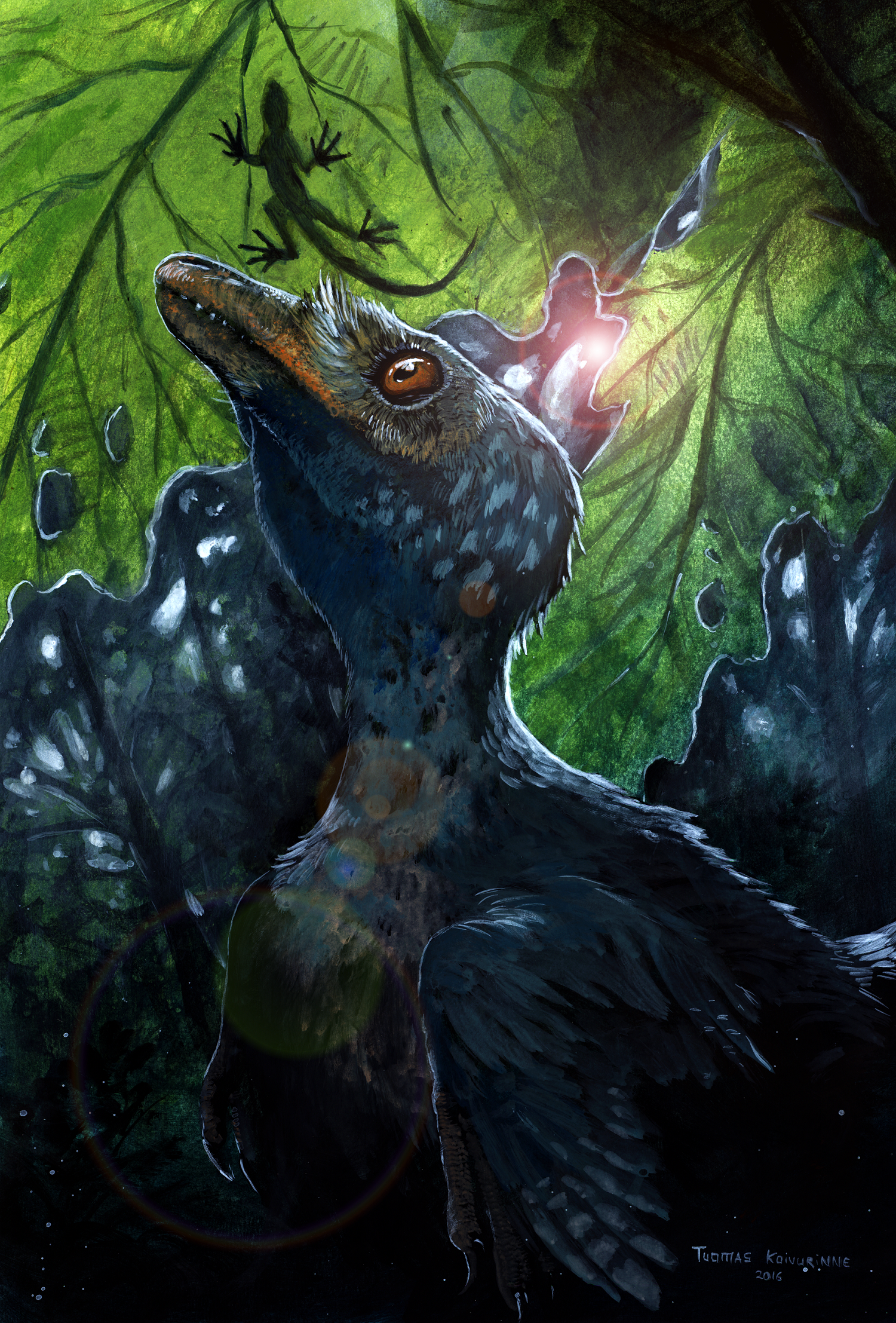
You might think that Crichton is trying to show that Levine is an idiot. But it’s stated that he’s “generally agreed to be the best paleobiologist of his generation, perhaps the best in the world” (417) and his “worldwide reputation forced him to continually travel around the world, inspecting new finds, and rendering his expert opinion to researchers who were annoyed to admit that they needed it” (430). So I think it’s pretty clear that the above conversation is intended to be accurate paleobabble. Disappointing.
Interesting conjectures
In addition to things that can be proved or disproved, Crichton gave his dinosaurs a lot of interesting and nuanced behaviors that have no basis in the fossil record but make sense nonetheless. Many of these involve herbivorous dinosaurs, which had much less screen time in the first book than the second.
Hypsilophodon bounding
The animals they call hypsilophodonts, or hypsys, are hard to pin down both taxonomically and in terms of physical characteristics. To be fair, the phylogeny of bipedal neornithischians is still in flux even now, and was more so back then, so it’s possible Crichton intentionally left this ambiguous. I think it’s a good bet that they were intended to belong to the genus Hypsilophodon given the way the narration refers to the other dinosaurs by a shortened version of their genus name, like calling Parasaurolophus “parasaurs” and Callovosaurus “callovosaurs”. The hypsys are alternately called “deer sized”, “gazelle-like”, and “kangaroo-like”, but later stated to weigh 500 pounds. Gazelles only weigh around 50 pounds, while kangaroos and most deer are closer to 150 pounds; perhaps the narration was referring to elk, which are 500 pounds and above. However, the real-life Hypsilophodon would only have weighed 40 pounds.
The hypsys are described as bounding like kangaroos. This is a good conjecture because of two factors: Hypsilophodon had long, strong back legs and small arms with grasping hands, similar to kangaroos, so it’s not impossible it would have been able to bound; and it lived in the chaparral environment of the Early Cretaceous Isle of Wight. Xerophytes, or desert-adapted plants, are found in the same deposits as Hypsilophodon, and for some reason, bounding is the best way to travel in the desert, as evidenced by kangaroos, jerboas, and Scleromochlus.
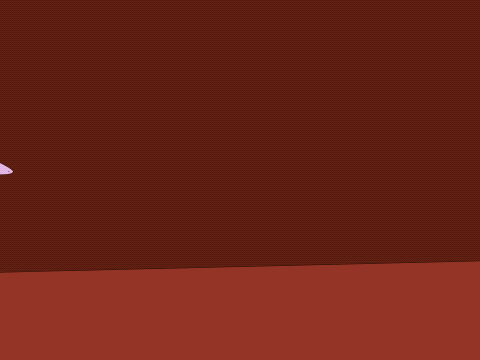
Parasaurolophus and Apatosaurus behavior
In the second book, we get to see a mixed herd of Apatosaurus (big, long-necked, long-tailed quadrupeds) and Parasaurolophus (the ones with the banana-shaped head crest) grazing together. Levine hypothesizes that “the apatosaurs are very strong but weak-sighted, whereas the parasaurs are smaller, but have very sharp vision. So the two species stay together because they provide a mutual defense. Just the way zebras and baboons stay together on the African plain. Zebras have a good sense of smell, and baboons have good eyesight. Together they’re more effective against predators than either is alone” (603). The herd then spots some stalking raptors, and the Parasaurolophus sound a trumpeting alarm that causes some Apatosaurus to turn their backs and threaten the raptors with their long whiplike tails. He also explains that Apatosaurus don’t raise their necks “very often, or for long periods” to reduce the load on the heart and esophagus, and mostly eat plants on the ground rather than from the tops of trees; and that the reason for the long necks is to “counterbalance the long tails” (587).
How realistic is this behavior? For one thing, Parasaurolophus and other advanced hadrosaurs (duck-billed dinosaurs) didn’t arise until very late in the Cretaceous, while the whip-tailed diplodocids, of which Apatosaurus is one, died out at the end of the Jurassic, some seventy million years earlier. So in real life, neither would have encountered any animals similar to the other, which means the Isla Sorna dinosaurs must have come up with this strategy on their own. This seems unlikely to me given that hadrosaurs and sauropods weren’t the sharpest tools in the shed. Maybe baboons follow zebras around with a full understanding of why, but for these dinosaurs to have done this the behavior would have had to have been selected for over many generations. I think it’s a really cool idea, and it’s true that many animals employ this strategy in real life (egrets and crocodiles, oxpeckers and wildebeest, and giraffes and zebras are some additional examples), but I would have chosen a different species than Parasaurolophus. Maybe Callovosaurus or a similar small Jurassic herbivore.
Did sauropods really have bad eyesight? Well, sauropod vision is very poorly researched even now, so it’s a reasonable thing to assume, especially since most large animals today, like rhinos, elephants, whales, and crocodiles, have not-so-good eyesight. But since dinosaurs are more closely related to birds, which have terrific eyesight and flashily colored bodies, they might have operated differently than today’s megafauna. Furthermore, giraffes have quite good eyesight, probably because their long necks give them a good vantage point to see a great distance. But then again, giraffes have really big eyes relative to their head size, and sauropods did not (with rare exceptions like Sarmientosaurus). And giraffes keep their necks upright all the time, while sauropods may or may not have–it’s still a matter of fierce debate. So, claiming that sauropods had bad eyesight is a reasonable conjecture with no hard evidence for or against it.
Did diplodocids really use their tails as whips? At the time of The Lost World’s writing, this idea was just speculation, and hadn’t yet been rigorously explored. Shortly after its publication, in 1997, scientists including Phil Currie, the inspiration for the character of Alan Grant, ran computer simulations of diplodocid tails and determined that the tail tip could have moved so fast it would have produced a sonic boom like a cracking whip. Many years later, they produced a physical model that could also produce cracking noises. Additionally, half of specimens of Diplodocus have a fused section of vertebrae between the stiff tail base and the flexible whip section, indicating high stresses in that region, which is to be expected if they were flinging their tails about at high speeds. It was proposed that perhaps only the males did the tail-whipping as a courtship display. However, there are alternate hypotheses that could explain the fused vertebrae: that those were the females, who experienced the stresses of a multi-tonne male mounting her during mating; or that these sauropods could stand up on their hind legs, using their tail as a tripod, to reach the highest leaves, and this section was where the tail bent between the body and the ground.
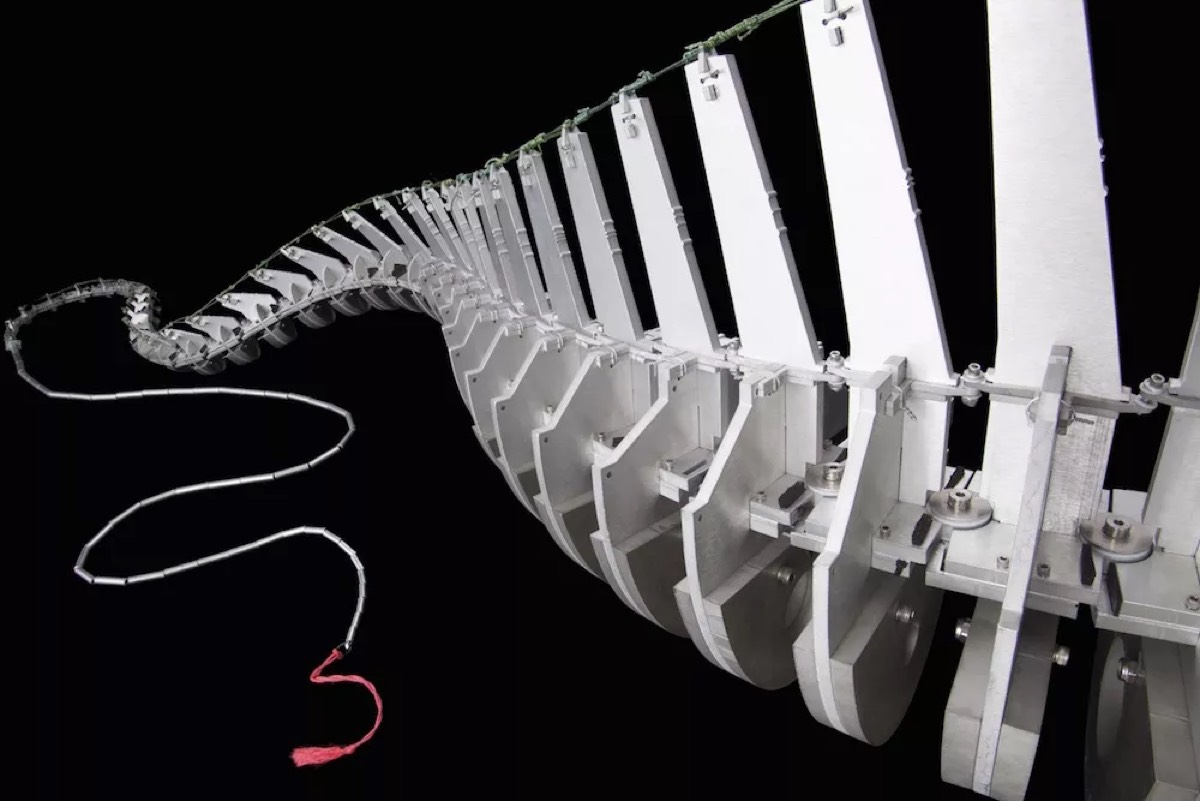
Finally, in 2022, the computer model was run again, this time with more consideration for the skin, tendons, and muscles that would have reduced the tail’s whippiness. This model produced an underwhelming 74 miles per hour at the tail tip, ten times slower than the speed of sound. Furthermore, when the tail was subjected to enough force to produce sound (more than the researchers thought the animal could realistically apply), the tail bones would break. [4] But, as always, a single study is not the last word on the issue. And even if sauropods couldn’t make whip-cracking sounds, it doesn’t mean that they didn’t use them as weapons to physically hit or deter attackers.
Did they really need a long neck to counterbalance the long tail? I don’t know if this hypothesis has ever been seriously examined, but it seems quite silly if you think about it for a minute. There are lots of other quadrupedal animals with big, heavy tails that have short necks, like hadrosaurs, stegosaurs, ankylosaurs, Komodo dragons, and crocodiles (the latter two often drag their tails, but they’re capable of walking or galloping with their tails held off the ground). On the flip side, there are quadrupeds with long necks and short tails, like azhdarchid pterosaurs, herons and storks, and giraffes. None of these animals tip over, simply because tails are not very heavy compared with the bulk of the body. It would take quite a ridiculous tail to shift the center of mass all the way to behind the back legs. But perhaps this is another example of Levine being overconfident and wrong…
Later on, Levine follows the Parasaurolophus herd as they walk single-file some distance into the jungle, to find out what they’re up to. When they reach their destination, they all urinate and defecate together. Then they leave, and a swarm of Procomsognathus appear and begin eating the fresh herbivore dung. Levine notes that rhinos and deer behave this way today, “as a method of marking territory” (633) to show predators that they’re a big herd, as well as to keep the poo away from the food. Could dinosaurs have done the same?
It’s very possible, but we don’t have direct evidence for it. Coprolites (fossilized poo) from the related hadrosaur Maiasaura have been found near their fossilized nests, indicating that at least when nesting, they didn’t use a latrine, possibly because they didn’t want to abandon the nest for any length of time. We do, however, have evidence of a more ancient non-dinosaur exhibiting latrine behavior: the dicynodont (early mammal relative that’s like a rhino crossed with a turtle) Dinodontosaurus. This tubby Triassic critter defecated so much that scientists were able to unearth 94 poos per square meter, in an area of 900 square meters! That’s like 85,000 poos! [5]
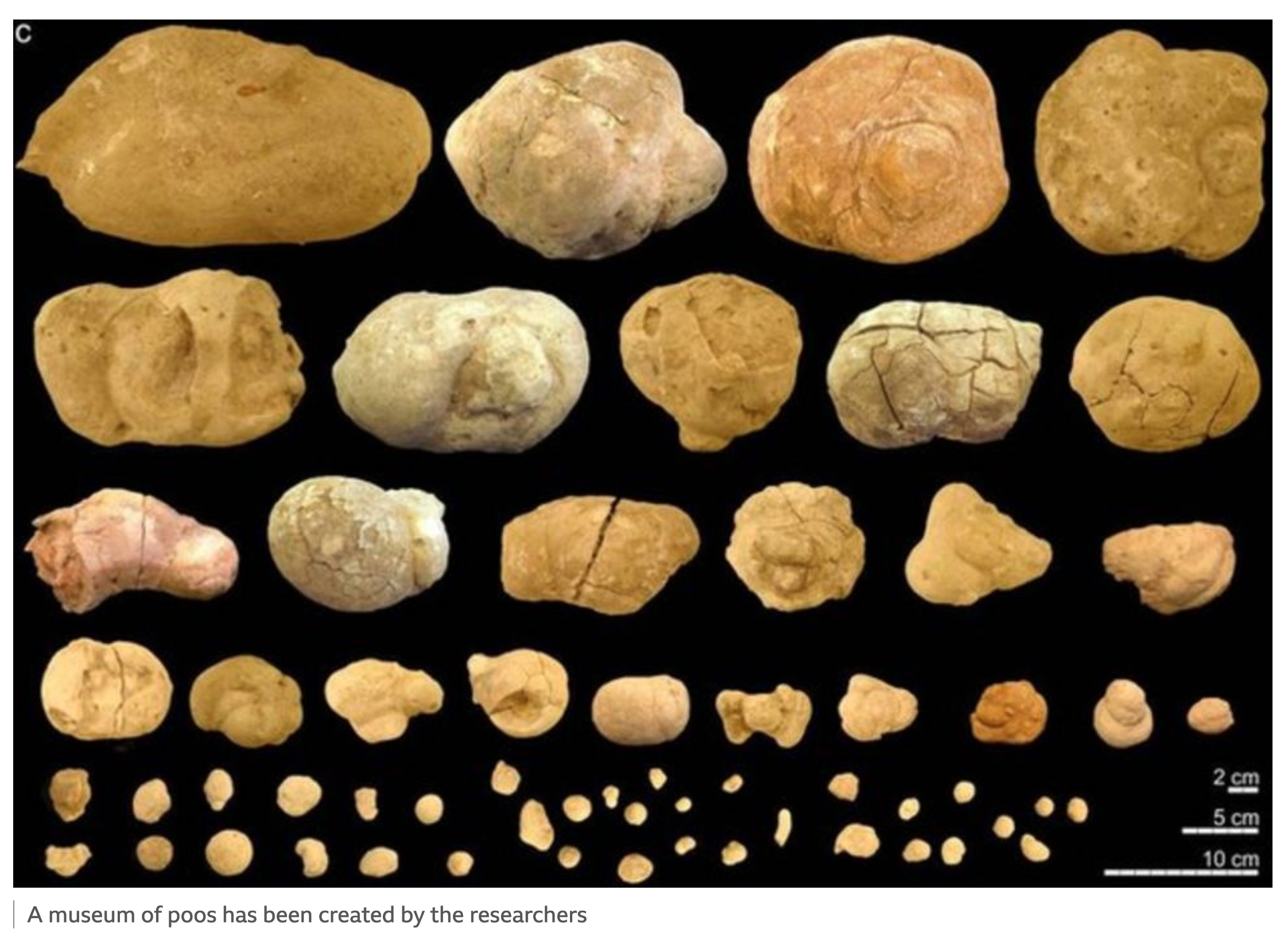
This latrine is a whopping 163 million years older than Parasaurolophus, which implies that latrine behavior in herding animals is not that complex. Since it provides benefits, it’s likely that at least some herding dinosaurs would have done it!
Does a diseased ecosystem support proportionally more carnivores?
Late in The Lost World, it’s revealed that the reason there are so many carnivores on Isla Sorna, more than expected for a normal ecosystem, is because all the dinosaurs are suffering from a prion disease called DX, which kills them before full adulthood. The abundance of corpses that results supports a high number of carnivores and scavengers (which also die young). Does this make sense?
In the book, Malcolm estimates that there are 500 prey animals on the island, and there are twelve adult raptors, two adult Tyrannosaurus, and two Carnotaurus. That’s a ratio of about thirty to one. Sarah says that’s “off by an order of magnitude,” and says, “In general, predator studies–whether tigers in India, or lions in Africa–all seem to show that you can support one predator for every two hundred prey animals” (687). However, there are a couple factors that make the situation with the dinosaurs different from the African savanna. One is that lions and tigers are of similar or greater weight than their prey, while the predatory dinosaurs on the island are on average less than half the size of the herbivores; and the other is that in the modern day, carnivores are persecuted by humans much more than herbivores are. A thirty to one ratio of predatory dinosaurs to prey is actually very close to what is observed in the fossil record. So they shouldn’t be surprised by the comparatively high number of carnivores.
What they should be confused about is the stability of a tiny, closed ecosystem packed with large animals with voracious appetites. Population dynamics are very sensitive to perturbations and can easily become unstable, causing one or both populations to crash to zero if the initial conditions and birth and death rates aren’t right. I made a simple model of the island ecosystem using differential equations, and tried different values for the parameters to get a sense for how sensitive the system was and what a stable ecosystem might look like.
The system of equations is very close to the standard Lotka-Volterra Equations, except I added a positive term to the predator equation to allow for cannibalism. However, since the biomass of predators is so small compared to the prey species, this term had a negligible effect.
Here’s the Python code I used to solve and plot the system of equations:

The parameters shown are my best guess of what the ecosystem described in the book was like. However, these parameters, which are supposed to represent the state of the island before the prion disease takes effect, result in this graph:
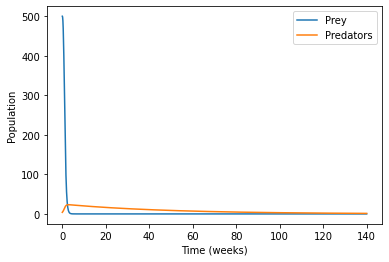
The predators are so voracious that they near-instantly kill all the prey, and then starve. Doubling the death rates for both predator and prey to model the disease results in an even steeper decline, as we assume all dead animals are consumed by predators. In the very short term, this does increase the ratio of predators to prey, and you could argue that the characters must be witnessing the island during this brief window before the inevitable population crash. However, the island dinosaurs have been supposedly living with this disease for five to ten years by the time the characters visit, so even if my model is off by two orders of magnitude in the time dimension, they would be too late to see any herbivorous dinosaurs.
I tweaked the parameters in order to get a system that was stable at a ratio of thirty to one, as described in the book. Such a system might look something like this:
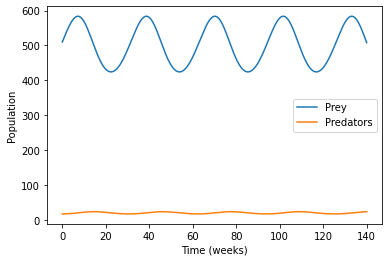
You can’t see it well because the predator count is always very low compared to the prey count, but they’re fluctuating between 17 and 25 individuals.
And doubling the death rates changes this system into this:
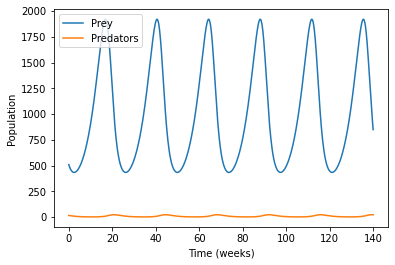
Now the predators are fluctuating between 4 and 25 individuals.
These graphs look nice, and would fit well with the narrative of the story. But unfortunately, the birth and death rate parameters they require are not reasonable. The predator death rate gamma has to be inflated by an order of magnitude, and the predation rate beta and predator birth rate delta have to be decreased by an order of magnitude. Basically, the predators would have to be a lot less predatory for a system of this size and ratio to work.
Note: The period of population change in these graphs seems really fast. In the diseased model, the prey population goes from 500 to 2000 in 20 weeks (less than half a year). But if you imagine a nesting season in which everyone’s laying lots of eggs, but then only a fraction of the eggs make it to adulthood, maybe this could make sense?
Note also: A population that drops down to four individuals is not robust and won’t last very long. Mathematically though, the model doesn’t care about the gene pool and will allow a population to recover even if it drops to fractional individuals. This is doubly improbable given this model has three different predator species, which means that six individuals are required to keep all three species breeding.
Anyway, I think the real reason there are so many predators on the island is so that the characters can be chased by a pack of scary raptors, and can help out a baby T. rex. But probably the seemingly high ratio of predators to prey was troubling Crichton, so he decided to find a way to explain it.
Conclusion
Good job getting this far, this was a long post. If you haven’t read the Jurassic Park books, you should. They’re page-turners, the characters are generally intelligent, and the dinosaurs are cool. The science holds up quite well even 33 years after its publication. I’ll probably even go seek out other works by Michael Crichton now. Recommended!
Image credits
Triassic dinos Cearadactylus Deinonychus Baby rex Deinonychus Bakker Stenonychosaurus
[1] Witton, M. Pterosaur.net: Terrestrial Locomotion. https://pterosaur.net/terrestrial_locomotion.php
[2] Orem, W. (2009, January 20). You Can’t Eat What You Can’t See. A Moment of Science - Indiana Public Media. https://indianapublicmedia.org/amomentofscience/eat.php
[3] Martin-Silverstone, L. People-snatching pterosaurs. (2015, February 19). Musings of a Clumsy Palaeontologist. https://gimpasaura.wordpress.com/2015/02/19/people-snatching-pterosaurs/
[4] Ouellette, J. (2022, December 8). Myth, busted: Apatosaurus didn’t produce sonic booms when whipping its tail. Ars Technica. https://arstechnica.com/science/2022/12/myth-busted-apatosaurus-didnt-produce-sonic-booms-when-whipping-its-tail/
[5] Daley, J. (2016, April 27). Giant prehistoric toilet unearthed. BBC News. https://www.bbc.com/news/science-environment-25126333
[6] Dawkins. (2022, November 16). Modeling With First-Order Differential Equations. Paul’s Online Math Notes. Retrieved August 22, 2023, from https://tutorial.math.lamar.edu/Classes/DE/Modeling.aspx

